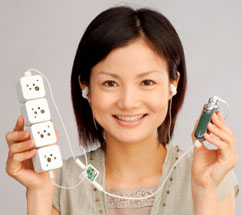WORLD'S SMALLEST HUMANOID ROBOTi-SOBOT Can Dance and Mimic Animals (August 31, 2007) |
| i-SOBOT poses with its programmable remote control. (©2007 TOMY Company, Ltd.) |  |
A new humanoid robot, certified as the world's smallest, will be released this autumn by Japanese toy manufacturer Tomy Company. On October 25, 2007, the Omnibot 17µ i-SOBOT is scheduled to hit the market—as well as the 2008 edition of Guinness World Records, which will list the product as "the smallest humanoid robot in production." Robotics fans look forward to i-SOBOT as a fun toy to add to their collections, but also as a leap forward in miniaturization of the advanced parts that go into these high-tech tools.
Surprising Size and Price
i-SOBOT stands just 16.5 centimeters tall, and weighs only around 350 grams. While the robot fits in the palm of your hand, it remains a fully outfitted bipedal machine, with 17 moving joints. Used throughout the body are tiny, custom servomotors developed by Tomy. The robot's onboard gyro-sensor allows it to maintain its balance automatically as it goes smoothly through its programmed motions. i-SOBOT comes with an infrared remote-control unit, but users can also use voice commands to control it.
Tomy's i-SOBOT architecture, the control system developed to operate this new robot, makes use of 19 integrated circuit chips that work in tandem to enable the toy's complex actions.
|
| The miniaturized robot fits comfortably in the palm of the hand. (©2007 TOMY Company, Ltd.) |  |
i-SOBOT will be sold for ¥29,800 before tax ($248 at ¥120 to the dollar) in fully assembled form, complete with rechargeable batteries and its remote control, which features twin joysticks, programmable buttons, and an LCD screen. According to the manufacturer, this price is quite affordable for a robot of this complexity. In addition to its release in Japan, the robot will make its way to markets in the United States and elsewhere in Asia. In 2008 Tomy intends to extend sales to Europe as well. To reach its global sales target of 300,000 units, the company is localizing i-SOBOT's software in English and Chinese in addition to Japanese.
Four Modes for Action
An attractive feature of this versatile robot is its four separate modes for controlling the action. In Remote Control Mode, the user manages the robot's movements directly with the command buttons and joysticks on the wireless remote. In Programming Mode, the user has the option to easily choose commands from a list of available actions—182 in all— or to use the controller to create original actions, or use a combination of the two to program complex sequences that can be up to 240 steps long, with 80 steps stored in each of the robot's three memory slots. Special Action Mode, meanwhile, includes 18 more complex preprogrammed actions, such as "hula dance" and "air drumming." And Voice Control Mode lets the user give the robot one of 10 commands, to which the i-SOBOT can respond with a range of actions.
This robot is entertaining to the ear as well as the eye. As it goes through its actions it plays sounds from its library of nearly 100 sound effects and songs. The speaker can be turned off, too, when silent action is preferable. The toy is humanoid in form, but the designers have included playful actions in its repertoire that have it imitate the adorable movements of animals.
Tomy has taken steps to make i-SOBOT eco-friendly. The toy manufacturer is shipping the robot with three rechargeable AAA batteries from Sanyo Electric Co., whose Eneloop nickel metal hydride batteries let users keep the robot running for months without sending dead batteries to landfills. Tomy is also collaborating in Sanyo's Energy Evolution Project by making i-SOBOT part of the programs carried out at Japanese elementary schools. The companies hope to boost children's awareness of environmental issues by powering the fun robot with rechargeable cells.
source: http://web-japan.org/trends/science/index.html











 The Matrix series' directors the Wachowski brothers have a pedigree that would perhaps find more widespread respect in Japan than the west. They began their narrative work as comic-book artists, working on Marvel Comics' Ectokid. In Japan, manga are seen as an alternate form of storytelling rather than the poor cousin of the novel, something with which the Wachowskis clearly concur. They are on record as big fans of anime, the animated version of manga, citing in particular their love of SF cult classics Akira (1988) and Ghost in the Shell (1996/98), which both began life as manga. In fact, the online Wikipedia contends that The Matrix contains direct allusions to both films:
The Matrix series' directors the Wachowski brothers have a pedigree that would perhaps find more widespread respect in Japan than the west. They began their narrative work as comic-book artists, working on Marvel Comics' Ectokid. In Japan, manga are seen as an alternate form of storytelling rather than the poor cousin of the novel, something with which the Wachowskis clearly concur. They are on record as big fans of anime, the animated version of manga, citing in particular their love of SF cult classics Akira (1988) and Ghost in the Shell (1996/98), which both began life as manga. In fact, the online Wikipedia contends that The Matrix contains direct allusions to both films: